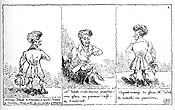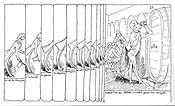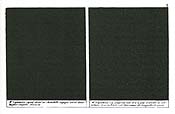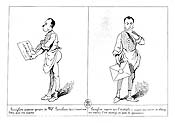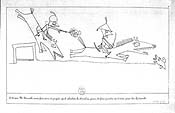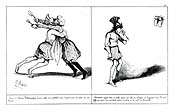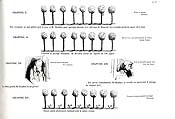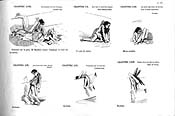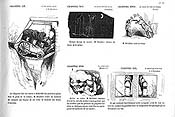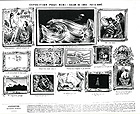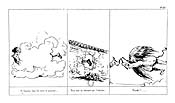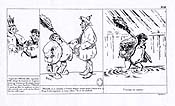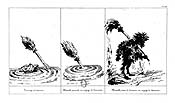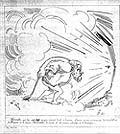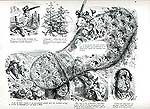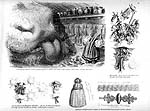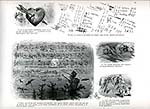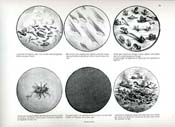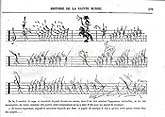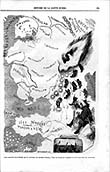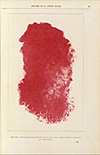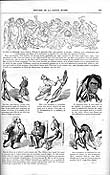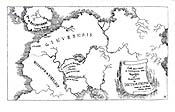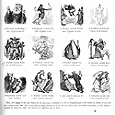The browser will either open the file, download it, or display a dialog.
|
|
Please note: selected figures are viewable by clicking on the figure numbers which are hyperlinked. |
|||||||||||||||||||||||||||||||||||||||||||||||
|
The Invention of Comics |
||||||||||||||||||||||||||||||||||||||||||||||||
|
The Swiss schoolmaster Rodolphe Töpffer (1799–1846) is usually credited with the invention of the comic strip, publishing seven of what we today would call comic books or, more recently, graphic novels. He drew his first, The Loves of Mr. Vieux Bois (fig. 1), in 1827, but did not publish it until ten years later, so his Story of Mr. Jabot (fig. 2) became, in 1835, the first published bande dessinée [drawn strip], a term more accurate than the English "comic strip" since such works are not always intended to be comic.1 Establishing a chronology depends upon our definitions, as David Kunzle has shown in his two-volume History of the Comic Strip, an indispensable tool for all scholars working in the area.2 While the genre was established incrementally over several centuries, with precedents ranging from broadsheets to the print series of William Hogarth, it was Töpffer who truly established the modern genre. Broadsheets often contained multiple images on a single page, but did not recount an original narrative, usually depicting instead well-known legends or events. Hogarth's print series did recount original narratives, but had each image printed on a separate sheet. If we define a comic strip as a single page or series of pages each containing multiple frames of images narrating an original story, then Töpffer undoubtedly created the first such works. Nonetheless, despite the explosion of interest in its later, particularly its contemporary, manifestations, there has been little work on its early history subsequent to Kunzle's study. It is important that we know this early history of comics, since current interest in the genre has already resulted in distortions in favor of twentieth-century manifestations. For example, the 2005–2006 exhibition "Masters of American Comics" attributed to twentieth-century American artists many of the innovations established a hundred years earlier. The accompanying exhibition at its Jewish Museum venue, "Superheroes: Good and Evil in American Comics," carried the astonishing statement by its curator Jerry Robinson, that "the first comic books were created in New York in 1934."3 | |||||||||||||||||||||||||||||||||||||||||||||||
| Art historians should be interested in the history of this genre, if for no other reason than that it is one of the most widely-disseminated examples of visual print culture in the modern era. Whether called comic strips, bandes dessinées, comic books, or graphic novels, these works constitute a hybrid medium, combining art and literature. Until recently, they had been dismissed from serious consideration by scholars in both areas. Töpffer recognized the hybridity of the medium and called his works "literature in prints" (la littérature en estampes).4 He also understood the prejudice against vernacular forms of both arts; fearful of damaging his reputation as a respectable schoolmaster, he held back publication of his works for several years, preferring instead to circulate them privately.5 | ||||||||||||||||||||||||||||||||||||||||||||||||
|
Such works should, of course, be investigated as both art and literature, but here I would like to consider them only in terms of their formal innovations, because the visual conventions invented by early comic strip artists, still in use today, created a language parallel to, but distinct from, that of painting, illustration, and even caricature. By the mid-nineteenth century, most of these visual conventions had been invented by Töpffer and his French followers. Although two of the major French caricaturists, Daumier and Grandville, had no interest in this new genre of publication, others, such as Cham and Gustave Doré, adopted it immediately and transformed Töpffer's invention. This can be shown by even a brief survey of the comic strip genre from 1827 to the publication in 1854 of Gustave Doré's Dramatic and Picturesque History of Holy Russia in Caricature (fig. 3), the longest graphic novel of the nineteenth century.6 Holy Russia contains five hundred drawings arranged on more than two hundred pages, and can be seen as marking the close of the second chapter in the creation of modern comic books, Töpffer himself having written the first. The influence of the bandes dessinées of these two decades can be seen not only in the subsequent history of comics, but even in early cinema, another new medium that had to grapple with the problem of sequential visual narration. | |||||||||||||||||||||||||||||||||||||||||||||||
|
Töpffer published his work in horizontal albums whose pages each contained only one tier (register) of images comprised of one or more panels, sometimes called frames or vignettes. As a result, his stories must be read in a linear, horizontal mode. On each drawing, below the panels, he handwrote his captions, so his published works have the appearance of a hand-written journal, very unlike the English tradition of speech balloons used in caricatures by Thomas Rowlandson and his successors. The entire sequence of drawings with captions was reproduced as an album in pen lithography using transfer paper, a method which did not reverse his drawings as would normal lithography and wood engraving. Töpffer's stories themselves owe much to the 1812 Tour of Doctor Syntax, whose images by Thomas Rowlandson and text by William Combe were the first to break with the moralizing tradition of Hogarth. The Tour of Doctor Syntax, however, included only one or two images for each chapter of text, akin to traditional book illustration, while Töpffer's stories were told entirely through images with only minimal text. Töpffer's stories were all organized around loose narratives of adventures, and, as literature, they should be understood within the tradition of the picaresque novel, in which the protagonist goes from one adventure to another with little character development. In terms of narrative strategies, these works differ markedly from the albums of lithographs, illustrations, or caricatures that had been popular in France and elsewhere for several decades.7 These earlier albums presented each image individually, not as part of a sequential narration. Even when linked by a common theme, such as travel, each image can be read and enjoyed in isolation from its neighbors. Töpffer's albums, in contrast, offered lengthy narratives recounted in hundreds of panels covering from forty to more than ninety pages. His drawing style differed markedly from traditional illustrational style in that it was more abstract, almost cursory, and used only line. Volume and space are indicated (if at all) by a scribbly line. Despite these differences, his treatment of events was very like that of illustration of the period, ultimately based on conventions adopted from painting. In Töpffer's work, the viewer is situated at a middle distance, a neutral observer of the events depicted. There are no distortions of scale, no close-up views, no departures from his set drawing style. Although Töpffer does vary the width of his panels, he maintains the boxed grid format with handwritten text below. Töpffer's stories are told through human agency, and what is depicted is seen from the reader's point of view, not that of the protagonist. Only in his last album, The Story of Albert, published in 1845, the year before his death, did he vary this style with the accordion-like images (fig. 4) that have since become familiar.8 | |||||||||||||||||||||||||||||||||||||||||||||||
| While I am not disputing Töpffer's primacy in the creation of the comic strip, I do want to point out that if we examine early comics in formal terms, we will find that many of the visual conventions that have since become familiar in modern comics were invented only gradually. This parallel language of signs and symbols developed in France in the 1840s and 1850s, and from there spread to other European and American countries. Before the mid-nineteenth century, the rest of Europe and the Americas had broadsheets and caricature, illustrated books and print series, but, outside of Switzerland, only France had a viable comic book tradition. French artists adopted Töpffer's new narrative mode and completed the transformation from illustration based on painting to the madcap modern language of comics. | ||||||||||||||||||||||||||||||||||||||||||||||||
| Soon after their publication, Töpffer's innovative comic books circulated throughout Europe and the United States, in pirated as well as authorized editions. They had their earliest influence in Paris when, in 1839, the Maison Aubert, established ten years earlier by the caricaturist Charles Philipon (1800–1862) with his half-sister Marie-Françoise-Madeleine Philipon and her husband Gabriel Aubert, published in plagiarized editions three of Töpffer's albums, Mr. Vieux Bois, Mr. Jabot and Mr. Crépin.9 Judging by the number of additional comic books that Aubert subsequently published, eight in the following four years, this must have seemed a promising new art form. Aubert titled these works its Collection des Jabots, named after Töpffer's first published album.10 The albums probably didn't sell very well, however, because between 1842, the year when Aubert published the tenth and eleventh (The Story of Prince Colibri and the Fairy Caperdulaboula and The Adventures of Telemachus, Son of Ulysses, both by Cham), and the very end of 1847 when the last of the collection, Gustave Doré's Labors of Hercules, was published, there were no additional albums in this series.11 Aubert did continue to publish collections of individual caricatures, however, often on a single theme but with no continuous narrative. It is not difficult to understand why these early comics had only a limited success: though ephemeral literature, they demanded too much concentration from the reader and really needed to be read at one sitting, while albums of collected caricatures, in contrast, could be enjoyed even if the reader had only a few moments available. Unlike Töpffer's albums, which often satirized contemporary society and as such were intended more for adults than for children, the early French comic book seemed to be an art form unsure of its audience. Too expensive and too long for children, their stories weren't interesting enough to attract adults. Collections of individual caricatures were more sophisticated and topical and, as a result, proved more attractive to an adult audience. | ||||||||||||||||||||||||||||||||||||||||||||||||
| Each of the twelve comic books published by Aubert in the Collection des Jabots has the same size and format, probably dictated by the publisher. Seven were written by the caricaturist Cham, the pseudonym of Amédée de Noé (1818–1879), who wrote his first two, The Story of Mr. Lajaunisse (fig. 5), and Mr. Lamélasse (fig. 6), in 1839, when he was twenty-one years old.12 An admirer of Töpffer, Cham later redrew the illustrations for Töpffer's Mr. Cryptogame when it was published in the journal L'Illustration in 1845.13 While it is undeniable that Töpffer influenced French artists, it is also possible that French artists might well have influenced Töpffer's later work, since many of the modern tropes of bandes dessinées made their first appearance in France. For example, the accordion-like images of Töpffer's 1845 Story of Albert, had appeared already in one of Aubert's Collection des Jabots, the 1840 Story of Mr. de Vertpré and His Housekeeper, often attributed to Cham but listed in Aubert's catalogues as by E. Forest.14 | ||||||||||||||||||||||||||||||||||||||||||||||||
| Subsequent albums in the Collection des Jabots were reminiscent of Töpffer's work in style and layout in that they utilized a horizontal format containing one or more boxed images in a single tier of panels reading from left to right with the text handwritten below. They even used pen lithography in emulation of Töpffer, although, since they did not use transfer paper, their printed images were reversed. Cham's style from the beginning, however, was more varied than Töpffer's, showing more volumetric drawing and shading, as well as the beginnings of the abstract language familiar to us in modern comics. In his comic books, Cham varied the scale of objects to show their importance, as when Mr. Lamélasse's servant carries a huge letter of invitation (fig. 6). Cham was also the first to combine different drawing styles. While Töpffer always drew like Töpffer, Cham could, for example, draw like a child, as he did in Mr. Barnabé Gogo (fig. 7), which recounts the life of an incompetent artist whose early efforts, the caption tells us, "could be mistaken for those of Géricault." He was also the first to expand the subjects of comics from contemporary life to include parodies of literature, such as his Adventures of Telemachus (fig. 8). Perhaps the most influential of his innovations was his inclusion of the all-black vignette shown in figure 5, where Mr. Lajaunisse blows out his candle and is left in darkness, and an all-white vignette in Two Marriageable Vaccinated Girls, where Cham states that he is too discreet to show the events. Although both had precedents in Laurence Sterne's Tristram Shandy of 1759–1767, Cham's publication of these panels disseminated the visual convention widely in both caricature and comic books.15 | ||||||||||||||||||||||||||||||||||||||||||||||||
|
In Cham's first seven comic books he adhered to the boxed grid formula of the Töpffer/Aubert layout, but during the five years when Aubert had ceased publishing this series, 1842 to 1847, he created Travel Impressions of Mr. Boniface, published in 1844 by Paulin.16 Printed from wood engravings, this album maintained the horizontal format, but its dimensions were larger than those of previous bandes dessinées. Artistically, Mr. Boniface was the most ambitious comic book after Töpffer's own work, surpassed only later by Gustave Doré's 1854 Dramatic and Picturesque History of Holy Russia in Caricature. There are dramatic differences between Mr. Boniface and Cham's earlier albums. In Mr. Boniface, Cham eliminated Töpffer's handwritten text and replaced it with standard typeface; with this one change, he took the comic strip out of the realm of the "artist's book" and brought it into the arena of the mass-produced printed book, where it has resided ever since. In fact, the term "comic strip" becomes somewhat of a misnomer here, since his panels were rarely arranged in strip format. He eliminated the boxed frames and, instead of Töpffer's single tier, he arranged each page's frames free form to read either top to bottom, left to right, or some combination thereof, depending on the events depicted. This innovation allowed him to create for the reader a kinesthetic equivalent to the narrative. When Mr. Boniface is on a boring coach voyage, for example, we are forced to follow the endless landscape across the horizontal page (fig. 9). When he is seasick (fig. 10), we re-enact the pitching of the boat by reading up and down, up and down, up and down, until we share his misery. Cham even added to each chapter heading a short apocryphal epigram commenting on its panel, satirizing the pomposity of "serious" books (especially those of the Romantics) and underscoring the distance traveled by this new irreverent comic genre. Since each "chapter" consists of only one image with a brief caption, he was also parodying the contemporaneous literary mode for long, multi-chapter books, particularly travel memoirs. Chapter LXX shows Monsieur Boniface's barking dog Azor, accompanied by the epigram, "'Do, re, mi, fa, sol, la, si, do.' – Rossini." Chapter XL's vignette of a ship's deck strewn with sea-sick passengers is accompanied by the legend, "'I am suffering.' – A Romantic."17 | |||||||||||||||||||||||||||||||||||||||||||||||
|
The frenetic rhythms of classic comic strips make their appearance in Monsieur Boniface (fig. 11) in a series of what in film technology are called "jumpcuts," abrupt shifts of viewpoint, a narrative technique that does not appear in cinema until the twentieth century. Figure 11 shows Mr. Boniface's view through his coach window where he sees only the coachman's boots, an image made all the more poignant by the inclusion of the epigram, "'Ah, Nature, how beautiful you are.' J.-J. Rousseau."18 By abandoning Töpffer's viewpoint of a neutral observer in favor of the highly-personal point of view of the protagonist, Cham has created a visual equivalent to the psychological transformation in literature that was also taking place during these decades, and that resulted in the modern novel. | |||||||||||||||||||||||||||||||||||||||||||||||
| An inventory of the formal innovations that Cham introduced into the comic book would be extensive, but it would have to include: the elimination of the boxed format, the substitution of typography for the hand-written text, the use of multiple tiers of frames in irregular formats, combinations of disparate styles, fragments, out-of-scale objects, different points of view, close-ups as well as distant views, and all-black or all-white panels. While it is indisputable that many of these visual conventions of modern comics made their first appearance in the work of Cham, there is still another precedent that must be addressed, a particularly French phenomenon called "The Salon in Caricature."19 | ||||||||||||||||||||||||||||||||||||||||||||||||
|
Well before the arrival of the comic strip, there had been caricatures of individual paintings, of course, but only in the 1840s, and only in France, were these images combined into entire pages, often entire "comic books" devoted to that year's Salon installation. The first was published in 1843 (fig. 12), one year before Cham's ground-breaking Travel Impressions of Mr. Boniface. In that year, Bertall, the pseudonym of the caricaturist Albert d'Arnoux (1820–1882), produced his humorous "Salon of 1843."20 Bertall has received virtually no scholarly attention, and yet the format of the Salon in caricature that he originated was soon adopted by Cham, Nadar, Gustave Doré and numerous others, and continued in France throughout the nineteenth century. On a single page, artists could caricature a variety of paintings—history, genre, landscape, still life, portraiture—each with its own scale, subject, and style, and combine the images into the free-form layouts soon to be familiar in comics (fig. 13). These caricatured Salons gave artists the freedom to break free of the Töpffer/Aubert format since here there were no strictures as to scale, style or narrative continuity, and the large pages of journals permitted an anarchistic layout of multiple frames. When the pages were hand-colored, as many of them were, their resemblance to modern comic books is even more striking. In any case, the first "Salons in Caricature" represent clear precedents for the free-wheeling combinations of imagery that soon appeared in French comics. | |||||||||||||||||||||||||||||||||||||||||||||||
| Although Cham continued to produce comic books after Travel Impressions of Mr. Boniface, none surpassed this volume. His later works, such as Soulouque and His Court of 1850 or The Adventures of Mr. Beaucoq of 1856, are more conventional both in drawing and in format.21 Most of his production after 1844 consisted of individual illustrations and caricatures, often published first in L'Illustration or Le Charivari, and then reissued as albums. He published over a hundred such albums as well as Salons in caricature, and continued to produce them until his death in 1879. | ||||||||||||||||||||||||||||||||||||||||||||||||
| It was the young Gustave Doré (1832–1883) who took up the bande dessinée, which, by 1847 had been abandoned by both Cham and by the Maison Aubert. Doré is the best-known illustrator of the nineteenth century, and yet his contributions to the development of the comic book remain virtually unknown and unacknowledged, probably because his career as a caricaturist and comic-book artist lasted less than eight years, from late 1847 to 1854, from when he was 15 to 22 years of age. During this time he produced thousands of images and four full-length comic books.22 When he wrote and drew The Labors of Hercules, he was only 15 but was already negotiating a contract to publish regularly in Philipon's new journal, Le Journal pour rire. Hercules was the twelfth and last album in the Collection des Jabots; after that the collection ceased, although the Maison Aubert did publish two later comic books by Doré in formats different from that of the earlier series. | ||||||||||||||||||||||||||||||||||||||||||||||||
|
In many ways, Doré's Labors of Hercules is outmoded, in that it follows closely the Töpffer model of a wavery linear style of drawing, executed in pen lithography with a single tier of boxed frames (fig. 14). Cham had already abandoned this format three years earlier. Like Töpffer, Doré included the handwritten text beneath the frame, and the album is intended to be read horizontally. Töpffer's subjects, however, had been contemporary, even politically charged, and he had never attempted a literary theme even in parody. In subject, Doré's Labors of Hercules recalls Cham's Adventures of Telemachus of 1842. It is not surprising that both young men chose to parody Greek mythology in the style of a lycée student, probably their intended audience, since the French educational system placed great emphasis on the classics. | |||||||||||||||||||||||||||||||||||||||||||||||
| Despite Cham's 14 years seniority over Doré, however, the younger man's creation is more unified and wittier. Even in his first youthful effort, Doré was already showing his narrative gifts. Artists do not often write interesting fiction, nor do many writers draw remarkable images. Rare is the individual like Töpffer or Doré who could do both. Doré exploited the rhythm of turning pages with the element of surprise that a new page could bring. Thus, when Hercules attempts to clean the Augean stables, a turn of the page shows him sinking into the mire (figs. 15 & 16). Modern viewers might notice that what is missing in all the early comic strips are the "speed lines" that have since become the standard sign for motion. In Töpffer's work, and even in the early pages of The Labors of Hercules, figures do not look like they are moving at all, but seem to be frozen in space. Doré actually invented this convention later in The Labors of Hercules where he depicts Cacus vomiting forth whirlwinds of flame (fig. 17). These speed lines have since become one of the most characteristic visual signs in the language of comics. | ||||||||||||||||||||||||||||||||||||||||||||||||
| Doré published three additional comic books after The Labors of Hercules. Three Artists Misunderstood and Malcontent (1850) and (Dis)Pleasures of a Pleasure Trip (1851) were both published by Aubert, although their style and formats differed markedly from that of the by-then defunct Collection des Jabots.23 Both were executed in lithographic crayon instead of pen lithography, resulting in a more illusionistic rendering. In Three Artists, Doré abandoned boxed frames and hand-written legends, as Cham had done earlier in his Mr. Boniface, but Doré carried Cham's free-form page layout to even greater extremes in (Dis)pleasures of a Pleasure Trip, where he first displayed the imaginative leaps characteristic of his later Holy Russia. | ||||||||||||||||||||||||||||||||||||||||||||||||
| (Dis)pleasures, reprinted three times and still in print today, was the most successful of Doré's first three albums. Its most extraordinary frame exploits shifts in scale in an unprecedented way. Doré recounts how the artist-protagonist, César Plumet, was drawing a local inhabitant of the Swiss Alps who slipped and stepped on his drawing. Doré shows the result of this mishap in his drawing of Plumet's drawing marred by a huge footprint across its surface (fig. 18). Later, when a cow licks Plumet's drawing, Doré draws the cow's huge muzzle and tongue looming over the tiny artist and drawing (fig. 19). In both panels, he shatters the illusionistic window and normative perspective that had governed art production from the Renaissance. Nor are Doré's stories told only through figures; now all kinds of visual imagery, objects, or even designs carry the story line forward. He draws frames that are not even "art," showing a close-up of Monsieur Plumet's account book (fig. 20) or his crossed-out sketchbook drawing, visible in figure 18. When Mme Plumet looks through her telescope, Doré shows us what she sees, in an extraordinary plate of six circular drawings (fig. 21), one even showing the fly that has landed on her telescope lens. With this bande dessinée, the last ties to traditional figure-centered illustration are severed in order to advance the narrative by any means available. Images expand and contract across the pages; on turning the page one can't be certain what one will find, sometimes a full-page drawing, sometimes up to 18 tiny ones. On occasion, readers cannot even be certain of the order in which the frames should be read. In addition, Doré's bande dessinée becomes self-referential in terms of formal innovations, and begins to establish a historiography of caricature and the comic book. He quotes Cham's all-black panels (when Mme Plumet looks through her telescope in figure 21) as well as the figurative musical compositions of Grandville, seen in figure 20 and instantly recognizable to Doré's readers. | ||||||||||||||||||||||||||||||||||||||||||||||||
| Nothing, however, prepares us for Doré's last foray into the world of the bande dessinée, his 1854 Dramatic and Picturesque History of Holy Russia in Caricature. Doré was then still a young man, only 22, when he wrote and drew this work, whose exuberance and sheer anarchy set it off from all previous examples of the genre. It was not published by Aubert, but by J. Bry aîné, who probably subsidized it since, despite its being the most ambitious comic book of the nineteenth century, with five hundred vignettes spread over 207 pages, it sold for only 4 francs, cheaper even than the much more modest albums of the Collection des Jabots. It represents not only the culmination of Doré's work in this medium, but also the culmination of the first phase of bandes dessinées and an introduction to the modern graphic novel. | ||||||||||||||||||||||||||||||||||||||||||||||||
| In Holy Russia, Doré rejects the horizontal album format that had characterized comic books since their inception, adopting instead a vertical format, which brought his publication further into alignment with "real" books. He abandoned the crayon lithography in which he had drawn his two previous comic books, in favor of wood engraving, a medium in which he would work for the rest of his life. His team of engravers was led by Eugène-Noel Sotain (1816–1874), who even received star billing on the book's front cover (fig. 3).24 | ||||||||||||||||||||||||||||||||||||||||||||||||
|
Holy Russia was published during the Crimean War, and took full advantage of the contemporary interest in all things Russian.25 Purporting to narrate the history of Russia, Doré takes the reader from the beginnings of recorded history (which he indicates with an all-black frame), to 1854 where he predicts French success in the Crimean War. His text is in the tradition of English humorous "histories," such as Gilbert Abbott à Beckett's The Comic History of England with illustrations by John Leech.26 Doré's text follows closely the actual events in the history of Russia, utilizing word/image counterpoint with numerous panels commenting on the text. A progressively more boring account of the origins of the Russian people is shown slowly being swallowed up by ink (fig. 22). No one earlier had so closely incorporated text with image. | |||||||||||||||||||||||||||||||||||||||||||||||
| Although much could (and should) be written on this masterpiece of the art of comics, here I will limit my discussion to Doré's formal innovations. His most striking formal innovation, already introduced in (Dis)pleasures, is his combination of numerous artistic styles into a kind of tour de force of the comic-book art. His homage to Cham includes not only all-black frames (pl. 2 & 31), but also a page of all-white ones (pl. 7) where, he tells us, the events are too boring to depict.27 There are several citations from Grandville, whom he obviously admired; once again, he borrows Grandville's musical motif (fig. 23), and this time also utilizes Grandville's figurative artist's pencil (fig. 24). The distinctive contour style of the English artist Richard Doyle, who drew for Punch, also appears in several panels, often in combination with other styles, as we can see in figure 24.28 Doré also parodied the mid-century interest in folk art by drawing in the style of Images d'Épinal (fig. 25). He even borrowed from Töpffer's Doctor Festus his map of the fictitious land of Ginvernais (fig. 26), remaking it into a map of Russia (fig. 27) and giving each region a satirical name such as Brutaslaw or Vaniteslaw.29 Interestingly, the only occasions in Holy Russia on which Doré utilized a standard grid format were where it demands to be read as satire. In figure 28, for example, the uniformity of the frames underscores the boring, repetitive nature of the recitation of Russian genealogy narrated by the text. The most dramatic pages in this album, however, which appeared in only a few copies, are where the relentless black and white of the text and illustrations are shattered by two pages stained red to symbolize the violence and bloodshed of the czars (fig. 29).30 | ||||||||||||||||||||||||||||||||||||||||||||||||
|
By combining panels of different styles, subjects, and scale on a single page or in a sequence of pages in his Dramatic and Picturesque History of Holy Russia in Caricature, Doré achieved a tour de force of the graphic arts. It is a summation of the comic-book art invented by Rodolphe Töpffer and transformed by French artists over the next two decades. |
||||||||||||||||||||||||||||||||||||||||||||||||
| Unfortunately for the history of comic books, Doré, like Cham before him, abandoned the medium. Early comic book artists found their work ill-paid and undervalued, so it is no surprise that they so often took their talents elsewhere. Soon after the publication of Holy Russia, Doré's illustrations to Rabelais were published and were greeted with such acclaim that he decided to devote himself henceforth to the more prestigious media of painting and book illustration. After this initial period of innovation, comic books actually became more conservative, and yet each of these early comic book artists, Töpffer, Cham, and Doré, contributed to the establishment of the language of comics, from Töpffer who invented "literature in prints," to Cham, who created many of its familiar visual conventions, to Doré, who, by deliberately transgressing all the newly-established comic-book traditions, established it as a subversive medium that obeys no rules, a definition still applicable today in the twenty-first century. | ||||||||||||||||||||||||||||||||||||||||||||||||
|
An earlier version of this paper was given under the title "Gustave Doré et le roman graphique" at the colloquium "Caricature: Bilan et recherches," held December 11–12, 2006 at the Institut National d'Histoire de l'Art in Paris, sponsored by the Centre d'Histoire de l'Art et d'Histoire des Représentations de l'Université Paris X Nanterre and by the Institut Universitaire de France. Because a number of the colloquium participants found my research important for their own work, I am publishing it here in order to make it available immediately, although it is part of a longer work-in-progress. I thank Ségolène Le Men, who organized the colloquium, Stephen Edidin, Madeleine Fidell-Beaufort, Raphaël Rosenberg, Petra ten-Doesschate Chu, Stuart Liebman, and Rose-Carol Washton-Long, all of whom have aided this project in various ways. A brief synopsis of this research was presented as "Gustave Doré and the Graphic Novel" in the session "Gustave Doré: Revisiting a Once-Famed Artist," chaired by Lisa Small and Eric Zafran on February 14, 2007 at the College Art Association Annual Conference in New York City. I am grateful to the Research Foundation of the City University of New York and to the Institut National d'Histoire de l'Art for their support, which has greatly facilitated my research. All translations are my own. Since "Mr." as an abbreviation for "Monsieur" often appears in the titles of the early bandes dessinées, I have left it in translation wherever it occurs. 1.Terminology is problematic since such works are not always in strip format, especially when published in book form, although newspapers preserve this layout. Rodolphe Töpffer, Les Amours de Mr. Vieux Bois (Geneva: J. Freydig, 1837); Rodolphe Töpffer, L'Histoire de Mr. Jabot (Geneva: J. Freydig, 1833). Although the Jabot album is dated 1833, Töpffer wrote that it had not been published until 1835; see R. T. [Rodolphe Töpffer], "Notice sur l'Histoire de Mr. Jabot," reprinted in Thierry Groensteen and Benôit Peeters, eds., Töpffer: L'Invention de la bande dessinée (Paris: Hermann, 1994), 161–63 [originally published in the Bibliothèque universelle de Genève, no. 18 (June 1837), 334–37]. The literature on Töpffer is extensive; Groensteen and Peeters reprint the artist's own writings on "literature in prints," and include a chronology and bibliography. A complete list of Töpffer's comic books includes: Histoire de Mr. Jabot [written in 1831], 1835; Les Amours de Mr. Vieux Bois [written in 1827] 1837; Mr. Crépin, 1837; Le Docteur Festus [written in 1829] 1840, Monsieur Pencil [written in 1831] 1840; Histoire de Monsieur Cryptogame [written in 1830] 1845; Histoire d'Albert [written in 1844] 1845. An eighth, Mr.Trictrac, was not published until 1937. 2. David Kunzle, History of the Comic Strip, 2 vols. (Berkeley and Los Angeles: University of California Press, 1973–90). I (and all scholars working on the subject) owe a profound debt of gratitude to David Kunzle for his ground-breaking panoramic survey of the medium through numerous centuries and countries. 3. The exhibition "Masters of American Comics" originated at the Hammer Museum and the Museum of Contemporary Art, Los Angeles, and traveled to the Milwaukee Art Museum, the Jewish Museum, and the Newark Museum; see John Carlin, Paul Karasik, and Brian Walker, eds., Masters of American Comics (New Haven: Yale University Press, 2005). There was no catalogue for the exhibition "Superheroes: Good and Evil in American Comics"; this quotation is taken from the introductory wall label. 4. Töpffer used the term in his "Réflexions à propos d'un programme," reprinted in Groensteen and Peeters, Töpffer, 144–60; see 150. 5. This was stated by Töpffer's earliest biographers, Auguste Blondel, Rodolphe Töpffer, l'écrivain, l'artiste et l'homme (Paris: Hachette, 1886), and Pierre-Maxime Relave, La Vie et les oeuvres de Töpffer (Paris: Hachette, 1886); see Kunzle, History of the Comic Strip, vol. 2: The Nineteenth Century, 38, for a brief summary of the evidence. 6. Gustave Doré, Histoire dramatique, pittoresque et caricaturale de la sainte Russie (Paris: J. Bry aîné, 1854). 7. See Patricia Mainardi, "Des débuts de la caricature lithographique à la Restauration," in Jean-Yves Mollier, Martine Reid, and Jean-Claude Yon , eds., (Re)Penser la Restauration (Paris, Editions du nouveau monde, 2005), 211–22. Ségolène Le Men has written extensively about the transformation of albums from children's literature to adult literature; see, in particular, "De l'image au livre: L'Éditeur Aubert et l'abédédaire en estampe, Nouvelles de l'estampe 90 (Dec. 1986), 17–30, and "Quelques définitions romantiques de l'album," Art et métiers du livre 143 (Feb. 1987): 40–47. 8. Rodolphe Töpffer, Histoire d'Albert, par Simon de Nantua (Geneva: Schmidt, 1845). 9. Mr. Crépin (Geneva: Frutiger, 1837); on Mr. Vieux Bois and Mr. Jabot, see n.1. The pirated Paris editions were all printed under the Aubert & Cie name. On the Maison Aubert, see James Cuno, "Charles Philipon, La Maison Aubert and the Business of Caricature in Paris, 1829–1841," Art Journal 43 (Winter 1983): 347–54. 10. The catalogue Aubert et Cie, Éditeurs, Place de la Bourse, 29, à Paris [1846] lists the following titles under the heading "Livres et albums comiques": "M. Jabot. Aventures d'un fat, joli album oblong. / M. Crépin. Différents systèmes d'éducation. / M. Vieux-Bois. Tribulations amoureuses d'un vieux fat. / M. Lajaunisse. Malheurs d'un beau garcon, par Cham (de N…) / M. Lamélasse. Histoire d'un épicier, par Cham (de N…) / M. de Vertpré. Employé retraité, par E. Forest. / M. Jobart. Mésaventures d'un homme naïf, par Cham (de N…) / Deux Vieilles filles à marier. Tribulations de famille, par Cham (de N…) / Un Génie incompris. Persécutions artistiques, par Cham (de N…) / Le Prince Colibri et la Fée Caperdulaboula, conte de fée, par Cham (de N…) / Télémaque, fils d'Ulysse, par feu M. de Fénélon et Cham (de N…). / Ces onze albums, connus sous le nom de Collection des Jabots, figurent sur toutes les tables des salons parisiens. Prix de chaque. 6 fr." The catalogue Etrennes de 1849, Publications d'Aubert et Cie, Éditeurs, Place de la Bourse, 29, à Paris [1848], lists "Les Travaux d'Hercule. Album dans le genre des Jabot-Crépin et autres du même format, par G. Doré. Prix 6 fr. Net 5 fr." The collection of the Bibliothèque Nationale is incomplete, lacking the 1847 catalogue. The title page of Cham's Un Genie incompris lacks the title, and the album has since become known as Mr. Barnabé Gogo after the protagonist. 11. Cham, Histoire du prince Colibri et de la fée Caperdulaboula (Paris: Aubert & Cie, 1842); Cham, Aventures de Télémaque, fils d'Ulysse (Paris: Aubert & Cie, 1842); Gustave Doré, Les Travaux d'Hercule (Paris: Aubert & Cie, 1847). 12. On Cham, see Félix Ribeyre, Cham: Sa vie et son oeuvre (Paris: E. Pon, Nourrit & Cie, 1884); and David Kunzle, "Cham, the 'Popular' Caricaturist," Gazette des beaux-arts, Dec. 1980, 213–24. 13. Mr. Cryptogame was published in wood engraving in L'Illustration, Journal Universel as "Histoire de M. Cryptogame, par l'auteur de M. Vieux-Bois, de M. Jabot, de M. Crépin, du Docteur Festus, etc." The publication began on January 25 and concluded on April 19, 1845. Not only were Töpffer's images reversed, but they were published in three tiers per page without their boxed formats, with some frames omitted. 14. E. Forest, Histoire de Mr. de Vertpré et de sa ménagère aussi (Paris: Aubert & Cie, 1840). E. Forest might have been Eugène Forest (1808–?), a caricaturist of the period who contributed to the same journals as Cham. David Kunzle identifies him as Edmond Forest, but there are no prints or publications in the Bibliothèque Nationale by an artist of that name; see Kunzle, History of the Comic Strip, 2: 85. 15. I am grateful to Raphaël Rosenberg for drawing my attention to these earlier precedents in Laurence Sterne's The Life and Opinions of Tristram Shandy, Gentleman (1759–67). The all-white pages appear in volume 7, chapter 38; volume 9, chapters 18 and 19. The all-black pages are in volume 1 between Chapters 12 and 13. Sterne's work is also cited in this context by Claude Moliterni, ed., Histoire mondiale de la bande dessinée (Paris: Pierre Horay, 1989), 20. 16. Cham, Impressions de voyage de Monsieur Boniface, Ex-réfractaire de la 4me, du 5me, de la 10me (Paris: Paulin, Libraire-Éditeur, 1844). Besides having his own publishing firm, Jean-Baptiste Paulin was the editor of L'Illustration, founded the previous year. Cham had already begun to contribute caricatures to this new weekly periodical. 17. "Chapitre XL 'Je souffre.' Un Romantique." Many of the captions contain puns, in-jokes, or word play. 18. "Chapitre XIX 'O nature! Que tu es belle.' –J.-J. Rousseau.'" 19. The most thorough study, including an extensive bibliography, is Marie-Claude Chadefaux, "Le Salon caricatural de 1846 et les autres salons caricaturaux," Gazette des beaux-arts, March 1968, 161–76; see also the Musée d'Orsay exhibition catalogue, Les Salons caricaturaux, ed. Thierry Chabanne (Paris: RMN, 1990). 20. Bertall, "Le Salon de 1843 (Ne pas confondre avec celui de l'artiste-éditeur Challamel, editeur-artist). Apendice au Livret. Représenté par 37 copies de Bertal," published first in Les Omnibus, 7me livraison [1843], and then reissued by the publisher Ildefonse Rousset that same year. 21. See Cham, Soulouque et sa cour (Paris: Le Charivari, 1850); Cham, Les Aventures de monsieur Beaucoq, ex-rosier de Nanterre (Paris: Arnauld de Vresse, 1856). 22. On Gustave Doré's comic books, see Henri Leblanc, Catalogue de l'oeuvre complet de Gustave Doré (Paris: Charles Bosse, 1931); Gabriele Forberg, Gustave Doré: Das Graphische Werk, 2 vols. (Munich: Rogner und Bernhard, 1975); Annie Renonciat, La Vie et l'oeuvre de Gustave Doré (Paris: ACR, 1983); 9e Art: Les Cahiers de la bande dessinée 3 (Jan. 1998). David Kunzle devotes a chapter of his History of the Comic Strip to Doré; see 2: 123–34. 23. Gustave Doré, Trois artistes incompris et mécontens. Leur voyage en province…et ailleurs!! Leur faim dévorante et leur déplorable fin (Paris: Aubert & Cie, 1850), Gustave Doré, Dés-agréments d'un voyage d'agrément (Paris: Aubert & Cie., 1851). 24. The cover text reads: "Histoire dramatique, pittoresque et caricaturale de la sainte Russie, d'après les chroniquers Nikon, Nestor, Sylvestre, Karamsin, Ségur, etc., etc., etc. / Commentée et illustrée par 500 magnifiques gravures par Gustave Doré / Gravées sur bois par toute la nouvelle école sous la direction générale de Sotain / Graveur de l'Histoire de Russie, de batailles, de portraits, de paysages, de genre, de fleurs, d'animaux, de crustacés et de plantes rares." ("Dramatic and Picturesque History of Holy Russia in Caricature, From the Chronicles of Nikon, Nestor, Sylvestre, Karamsin, Ségur, etc., etc., etc. / Annotated and Illustrated by 500 Magnificent Engravings by Gustave Doré / Engraved on Wood by the Entire New School under the General Direction of Sotain/ Engraver of the History of Russia, of Battles, of Portraits, of Landscapes, of Genre, of Flowers, of Animals, of Crustaceans, and of Rare Plants.") 25. The illustrated press was full of commentary about the war and several collections of caricatures were republished as albums after first having appeared in journals such as Le Charvari. To cite only two: Messieurs les Cosaques. Relation charivarique, comique et surtout véridique des hauts faits des Russes en Orient. Par MM. Taxile Delord, Clément, Carraguel et Louis Huart. 100 vignettes par Cham (Paris: Plon, 1854); Les Cosaques pour rire. Album de quarante caricatures par MM. Cham, Daumier & Charles Vernier (Paris: Le Charivari, 1854). 26. See Gilbert Abbott à Beckett, The Comic History of England: From Julius Caesar to George II, 2 vols. (London: Punch, 1847–48). John Leech did two hundred illustrations for the edition, but they are dispersed throughout the two volumes, with only one or two in each chapter. 27. The all-black vignettes appear on plates 2 and 31; plate 7 contains five all-white vignettes. 28. Richard Doyle's work was often plagiarized by French illustrated journals; throughout 1849, Doré published dozens of illustrations in Doyle's style in Le Journal pour rire. 29. Some of Doré's other regional names include Personalitaslaw, Bétissgorod, Furiroslaw, Honteslaw. See also Rodolphe Töpffer, Le Docteur Festus [1829] (Geneva: Schmidt, 1840), plate 88, printed as page 1. Although Töpffer labels England as Rondeterre [Roundland] instead of Angleterre [literally Angleland] on his map, he never really exploited the comic possibilities of regional names. A recent example of this trope is "NewYorkistan" by Maira Kalman and Rick Meyerowitz, which appeared as the cover of The New Yorker on December 10, 2001. 30. No doubt it was the expense that prevented all the examples of this album from being hand-colored since albums with hand-colored prints sold for considerably more than those with only black-and-white prints.
|
||||||||||||||||||||||||||||||||||||||||||||||||
|
||||||||||||||||||||||||||||||||||||||||||||||||



